|
|
|
Sort Order |
|
|
|
Items / Page
|
|
|
|
|
|
|
| Srl | Item |
| 1 |
ID:
166865
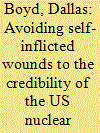

|
|
|
|
|
| Summary/Abstract |
Nuclear deterrence requires not only the reliability of a state’s strategic weapons and the willingness of its leaders to employ them but also an adversary’s appreciation of these conditions. Weapons perceived as failing to hold their targets at risk may lack deterrent value, just as retaliatory threats that are not believable may fail to deter, even if a state’s operational capabilities are robust. Both the technical and political credibility of the US nuclear deterrent may have suffered self-inflicted harm since the end of the Cold War, often as casualties of intemperate policy debates. In particular, doubts have been sowed about the reliability of aging US warheads under a science-based stockpile-stewardship regime meant to substitute for nuclear-explosive testing. Likewise, the credibility of US deterrent threats may have waned as American leaders have spoken ever more stridently about the horrors of nuclear war and nuclear terrorism, underscoring their extreme aversion to the risk of nuclear attack. Diminished credibility in both spheres threatens to compromise US national-security objectives ranging from nuclear nonproliferation to the outcomes of nuclear crises.
|
|
|
|
|
|
|
|
|
|
|
|
|
|
|
|
| 2 |
ID:
166868


|
|
|
|
|
| Summary/Abstract |
The end of the 1987 Intermediate-range Nuclear Forces (INF) Treaty has the potential to plunge Europe and NATO into deep crisis. Russia’s continued violation coupled with the Donald J. Trump administration’s desire to balance against Moscow and Beijing could force a new missile debate on Europeans. Even though Washington is trying to assuage its allies, the specter of another round of INF missile deployments to Europe is not unrealistic. Meanwhile, NATO’s European members face a dilemma. Some want NATO to resolutely push back against Russia. Others want to avoid a new deployment debate, at almost all costs. The Kremlin will use these cleavages to weaken NATO. If not carefully handled, NATO’s response to the Russian missile buildup could lead to domestic turmoil in a number of European states and render the alliance ineffective for a prolonged period. Europeans need to act now and voice their preferences in the military and diplomatic domains. A number of different military options are available, below the level of deploying new INF missiles in Europe. However, Europeans need to consider trade-offs regarding crisis and arms-race stability. At the same time, it will be up to European capitals to conceptualize a new arms-control framework for the post-INF world, one that takes into account today’s geopolitical realities and the entanglement of modern conventional and nuclear forces. Given the Trump administration’s loathing of arms control, concepts of mutual restraint may well have to wait for the next US administration. In any case, that should not stop Europeans from taking on more responsibility for their own security.
|
|
|
|
|
|
|
|
|
|
|
|
|
|
|
|
| 3 |
ID:
166861
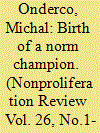

|
|
|
|
|
| Summary/Abstract |
In 1995, South Africa was in a special position. It was: a new party to the Treaty on the Non-Proliferation of Nuclear Weapons (NPT), the first country to voluntarily renounce nuclear weapons, led by a charismatic leader, and seen as a champion of disarmament principles. Yet South Africa’s new leaders were also interested in affirming their position within the Non-Aligned Movement, which was adamantly opposed to the NPT’s indefinite extension. Why, then, did South Africa decide to support the indefinite extension of the NPT in 1995? Existing scholarship has ascribed too much credit to pressure from the United States, overlooking domestic debates in South Africa and the bifurcation between professional diplomats and political elites. This article, building on new archival sources and in-depth oral-history interviews with major actors, demonstrates that South African diplomats opposed indefinite extension while South African policy elites allocated little attention to the topic until late in the game. The findings contribute to our understanding of South Africa’s norm entrepreneurship, as well as the politics of global nonproliferation.
|
|
|
|
|
|
|
|
|
|
|
|
|
|
|
|
| 4 |
ID:
166864
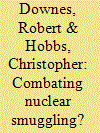

|
|
|
|
|
| Summary/Abstract |
International concern over nuclear terrorism has grown during the past few decades. This has driven a broad spectrum of efforts to strengthen nuclear security globally, including the widespread adoption of radiation-detection technology for border monitoring. Detection systems are now deployed at strategic locations for the purported purpose of detecting and deterring the smuggling of nuclear and radioactive materials. However, despite considerable investment in this area, few studies have examined how these programs are implemented or the operational challenges they face on a day-to-day basis. This article seeks to address this with a focus on radiation-detection efforts at maritime facilities. Utilizing practitioner interviews and a survey, this article identifies the factors that influence the planning and use of these systems in this fast-moving environment. The results clearly demonstrate that the implementation of these systems varies significantly across different national and organizational contexts, resulting in a fragmented global nuclear-detection architecture, which arguably undermines efforts to detect trafficked nuclear-threat materials. Greater consideration should therefore be given to developing international standards and guidance, designing and adopting tools to support key parts of the alarm assessment process, and broader sharing of good practice.
|
|
|
|
|
|
|
|
|
|
|
|
|
|
|
|
| 5 |
ID:
166862
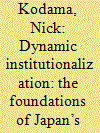

|
|
|
|
|
| Summary/Abstract |
Many have suggested that the true purpose behind Japan’s development of a closed nuclear-fuel cycle is to maintain the technical potential to develop nuclear weapons. However, closer examination of the development of Japan’s nuclear industry shows that, although Japan possesses advanced nuclear technologies, there has been no deliberate strategy to create a nuclear-weapon option. There is no “nuclear hedge.” To illustrate this point, this article presents a framework called “dynamic institutionalization” to explain the origins of Japan’s nuclear policies and the different sets of institutionalized pressures and constraints that have perpetuated these policies over time. Japan’s continued development of closed fuel-cycle technologies is primarily driven by domestic politics and the lack of a permanent spent-fuel management solution. On the other hand, Japan’s institutionalized nuclear forbearance is driven by the calculation that, as long as US extended deterrence remains credible, Japan’s security is best guaranteed through reliance on the US nuclear umbrella. By analytically untangling the policy of closed fuel-cycle development from the rationale for nuclear forbearance, this article provides a more nuanced view of the relationships between the domestic and international variables shaping Japan’s nuclear policies.
|
|
|
|
|
|
|
|
|
|
|
|
|
|
|
|
| 6 |
ID:
166867


|
|
|
|
|
| Summary/Abstract |
This article analyzes the North Korean nuclear crisis from a balance-of-power perspective. It is in the long-term interests of international peace for a secure and independent North Korea to serve as a buffer between US and Chinese ground forces. However, the conventional military advantage of the South Korean-American alliance over North Korea has grown drastically since the end of the Cold War, threatening North Korea’s survival. Since North Korea lacks any reliable ally, nuclear weapons represent its most cost-effective way to restore a balance of power and thus secure itself. Accepting security guarantees in exchange for its nuclear arsenal is rhetorically appealing but not a viable approach. North Korea’s development of intercontinental ballistic missiles (ICBMs), however, has overcompensated for the post-Cold War imbalance, inviting talk in Washington of waging a preventive war. Persuading North Korea to give up its ICBM capability, not its nuclear arsenal, should therefore be the primary objective of US diplomacy.
|
|
|
|
|
|
|
|
|
|
|
|
|
|
|
|
| 7 |
ID:
166863
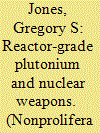

|
|
|
|
|
| Summary/Abstract |
The claim that reactor-grade plutonium cannot or will not be used to produce nuclear weapons has been used to justify non-nuclear-weapon states’ large stockpiles of plutonium that has been separated from highly radioactive spent fuel. However, by using reduced-mass plutonium cores, it is possible to manufacture reliable nuclear weapons with reactor-grade plutonium. These weapons can have the same design, size, weight, and predetonation probability as weapons using weapon-grade plutonium and would require no special cooling. The increased radiation from reactor-grade plutonium could be easily managed by shielding and operational procedures. Weapons using plutonium routinely produced by pressurized-water reactors could have a lethal area between 40 percent and 75 percent that of weapons using weapon-grade plutonium. In the past, both Sweden and Pakistan considered using reactor-grade plutonium to produce nuclear weapons, and India may be using reactor-grade plutonium in its arsenal today. Despite claims to the contrary, the United States used what was truly reactor-grade plutonium in a successful nuclear test in 1962. The capability of reactor-grade plutonium to produce highly destructive nuclear weapons leads to the conclusion that the separation of plutonium, plutonium stockpiling, and the use of plutonium-based fuels must be phased out and banned.
|
|
|
|
|
|
|
|
|
|
|
|
|
|
|
|
| 8 |
ID:
166866


|
|
|
|
|
| Summary/Abstract |
The US government initiated a Defense Counterproliferation Initiative to address the concern that, in the post-Cold War years, the proliferation of nuclear, biological, and chemical weapons would be widespread and create a significant challenge to the US military’s combat operations. In particular, non-nuclear states might use chemical or biological warfare agents against US forces with the belief that nuclear weapons would not be used against them in retaliation. Following the events of September 11, 2001, defense strategy and policy shifted to a wider view of the threat of adversarial use of “weapons of mass destruction” (WMD) and the term “counterproliferation” was replaced by “combating” or “countering WMD.” Over time, the Defense Department increasingly moved away from counterproliferation principles with the detrimental effect of losing capabilities that US forces still need for contemporary adversaries. This shift has been aggravated by other US government agencies’ use of “counterproliferation” in lieu of what would have been termed “nonproliferation” activities in the 1990s. The loss of clarity within the US government on these terms has led to the inability to focus the “whole of government” on this significant national security challenge. To alleviate this challenge, the US government needs a top-down initiative to refocus policy on the distinctly different aspects of WMD with respect to military combat operations, combating terrorism, and homeland security.
|
|
|
|
|
|
|
|
|
|
|
|
|
|
|
|
| 9 |
ID:
166860
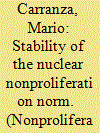

|
|
|
|
|
| Summary/Abstract |
This article argues that the nuclear nonproliferation norm (NNPN) is a social fact with a relatively independent life of its own and that it has a powerful impact on the behavior of both nuclear-weapon states (NWS) and non-nuclear-weapon states (NNWS). It challenges the application of critical constructivist research on norms to the NNPN and the idea that its legitimacy and structural power depend on contestation “all the way down.” State and non-state actors play an important role in explaining the dynamics of the NNPN, but agential constructivism runs the danger of “throwing the baby out with the bath water,” neglecting the structural impact of the NNPN on state behavior. The article examines the limitations of norm-contestation theory, arguing that some norms are more resistant to contestation than others. The NNPN is more difficult to contest than new norms (such as the Responsibility to Protect) because it is rooted in fifty years of nonproliferation nuclear diplomacy. The US-India nuclear deal is not a case of “norm change” but a violation of the NNPN. The “core” of the NNPN has not changed since the US-India nuclear deal. The conflict confronting NWS and NNWS is about the implementation of “type 2” norms (organizing principles) and “type 3” norms (standardized procedures), and not about the “hard core” of the NNPN.
|
|
|
|
|
|
|
|
|
|
|
|
|
|
|
|
|
|
|
|
|